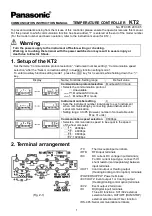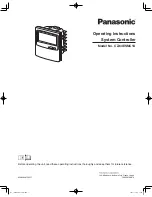
6
Pressure Regulators with Type SP/P Safety Pilot
Troubleshooting
If Regulator Fails to Open – or Fails to
Open Sufficiently (Delivery Pressure Will
Not Build Up):
1. Make sure that both inlet and outlet stop valves
are open.
2. Try raising the delivery pressure by adjusting the
setting of the pilot.
3. Make sure that the initial pressure is reaching the
inlet of the regulator–blow down strainer ahead
of regulator.
4. Close the stop valves and remove both copper
tubing bends. Test operation of pilot by cracking
open the inlet stop valve and observing discharge
from pilot. Increase the pressure setting of pilot, if
necessary, to get discharge. If discharge cannot
be obtained, pilot is fouled with dirt and should be
disassembled and cleaned. If pilot is badly fouled,
main valve should also be examined. Remove
blind flange from top of main valve and clean out
all foreign matter.
5. Before replacing tubing bends, check the
bleedport fitting to make sure it contains an orifice
(3/32 in. / 2.38 mm). Also check the restriction
ell at bottom of main valve and make sure it
is not plugged. Blow out tubing bends before
replacing them.
6. Should regulator function normally at low loads,
but fail to maintain the delivery pressure on
high loads, it probably is not big enough for
the demand.
If Regulator Fails to Close (Delivery
Pressure Builds Up Too High):
1. If there is a bypass valve, make sure that it is
not leaking.
2. Try lowering the delivery pressure by changing the
pilot setting.
3. Close the stop valves and remove both tubing
bends and inspect both the bleedport and
restriction ell to make sure they are not obstructed.
Remove
all
compression from the pilot adjusting
spring and then crack the inlet stop valve. If steam
issues from the pilot valve, the trouble is in the
pilot. If steam issues from the bleedport opening,
the trouble is in the main valve.
If trouble is in the pilot, it should be completely
dismantled, cleaned and the disk lapped in with
FINE
grinding compound (never use coarse).
If trouble is in the main valve, remove blind flange
from top and see if there is an obstruction between
the seat and disk that keeps main valve from closing.
If so, it may be possible to remove obstruction with
long nose pliers or a piece of stiff wire. If obstruction
cannot be removed, or is not visible, dismantle main
valve completely, clean thoroughly and lap in disk with
fine compound.
A tire pump and a ‘snifter’ valve can often be
successfully used to remove an obstruction from
between the seat and disk of the main valve. Replace
the restriction ell with the ‘snifter’ valve and pump air
pressure (10 to 20 psi / 0.69 to 1.38 bar) under the
main valve diaphragm. This will open main valve wide
and the obstruction can be removed with a piece of
wire (do not use fingers).


























